Intranasal Vaccination with a Respiratory-Syncytial-Virus-Based Virus-like Particle Displaying the G Protein Conserved Region Induces Severe Weight Loss and Pathology upon Challenge with Wildtype Respiratory Syncytial Virus
Abstract
:1. Introduction
2. Materials and Methods
2.1. Cells, Antibodies, and Viruses
2.2. Plasmids
2.3. Cell ELISA to Measure Fstem/GCR Levels on the Surface of Transfected Cells (Figure 1)
2.4. Western Blots (Figure 2)
2.5. Western Blots (Figure 4 and Figure 6)
2.6. Electron Microscopy (Figure 3)
2.7. Production of VLPs for Mouse Studies
2.8. Vaccination Protocol and Serum Ab Collection (Figure 4 and Figure 6)
2.9. ELISA to Measure Anti-Viral Ab Levels in Mouse Sera (Figure 4 and Figure 6)
2.10. Challenge Studies (Histopathology) (Figure 5 and Figure 7)
2.11. Mouse Ethics Statement
2.12. Statistics
3. Results
3.1. Determining the GCR Length for Optimal Surface Expression and Recognition by Known Anti-CCR Abs (Figure 1)
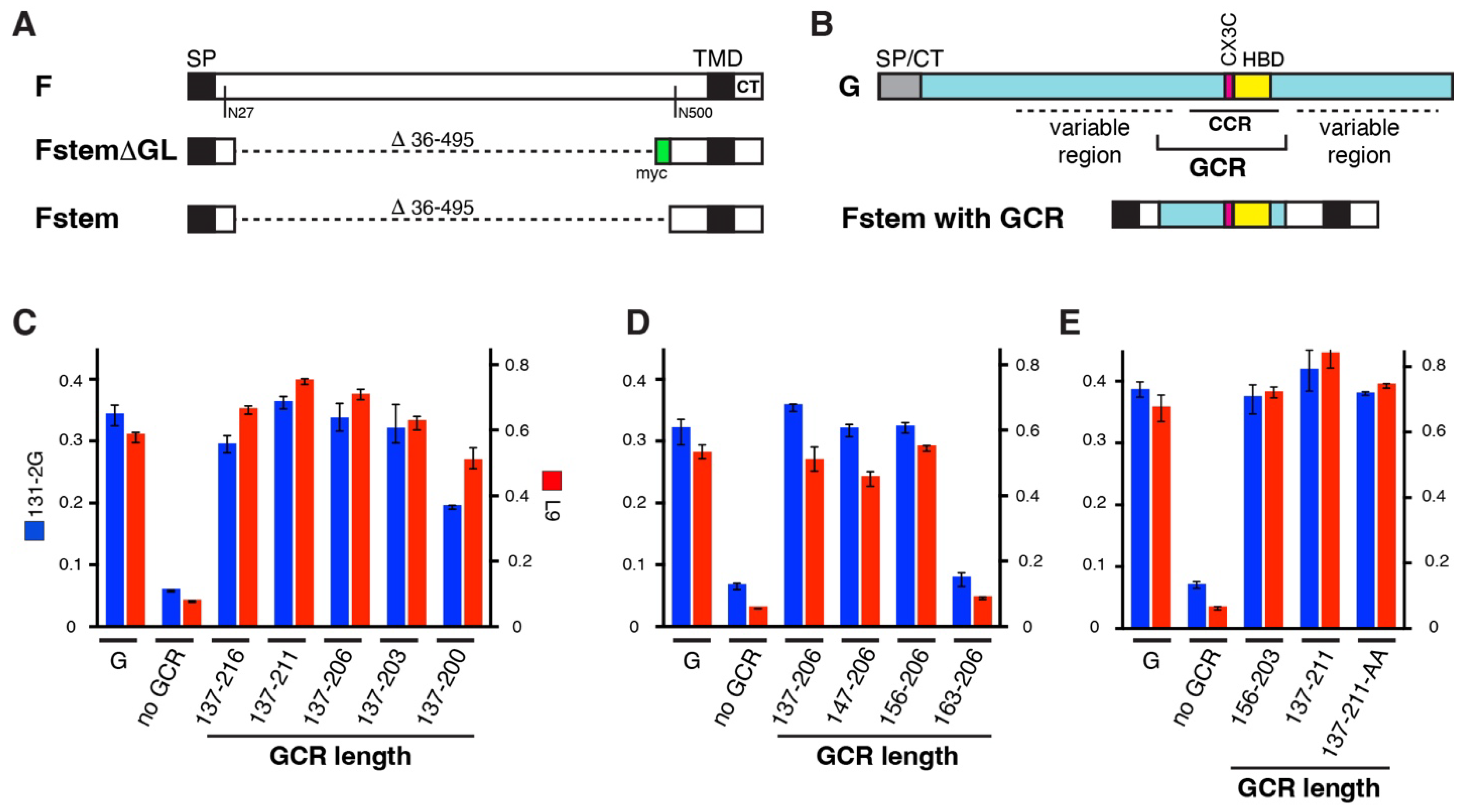
3.2. Generation of RSV-Based VLPs Containing Fstem Proteins with GCR Peptides of Various Length (Figure 2)
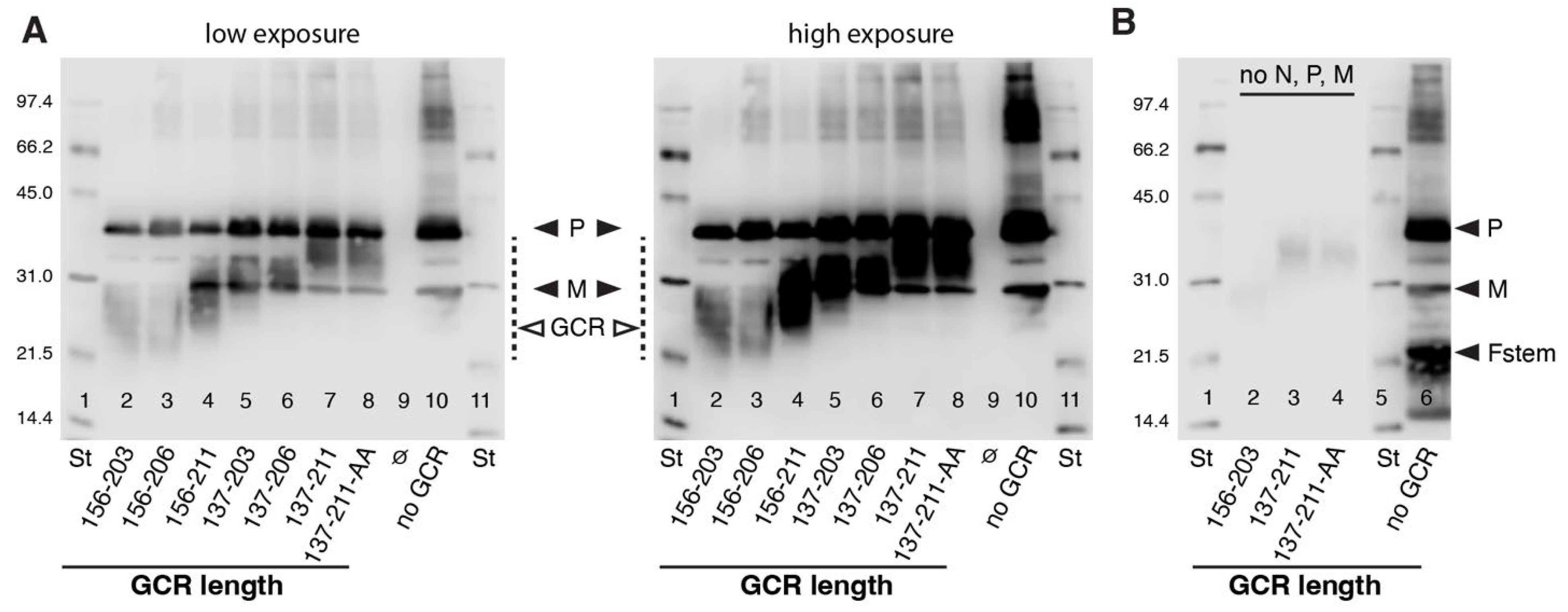
3.3. High Resolution Analysis of VLPs Displaying GCR (Figure 3)
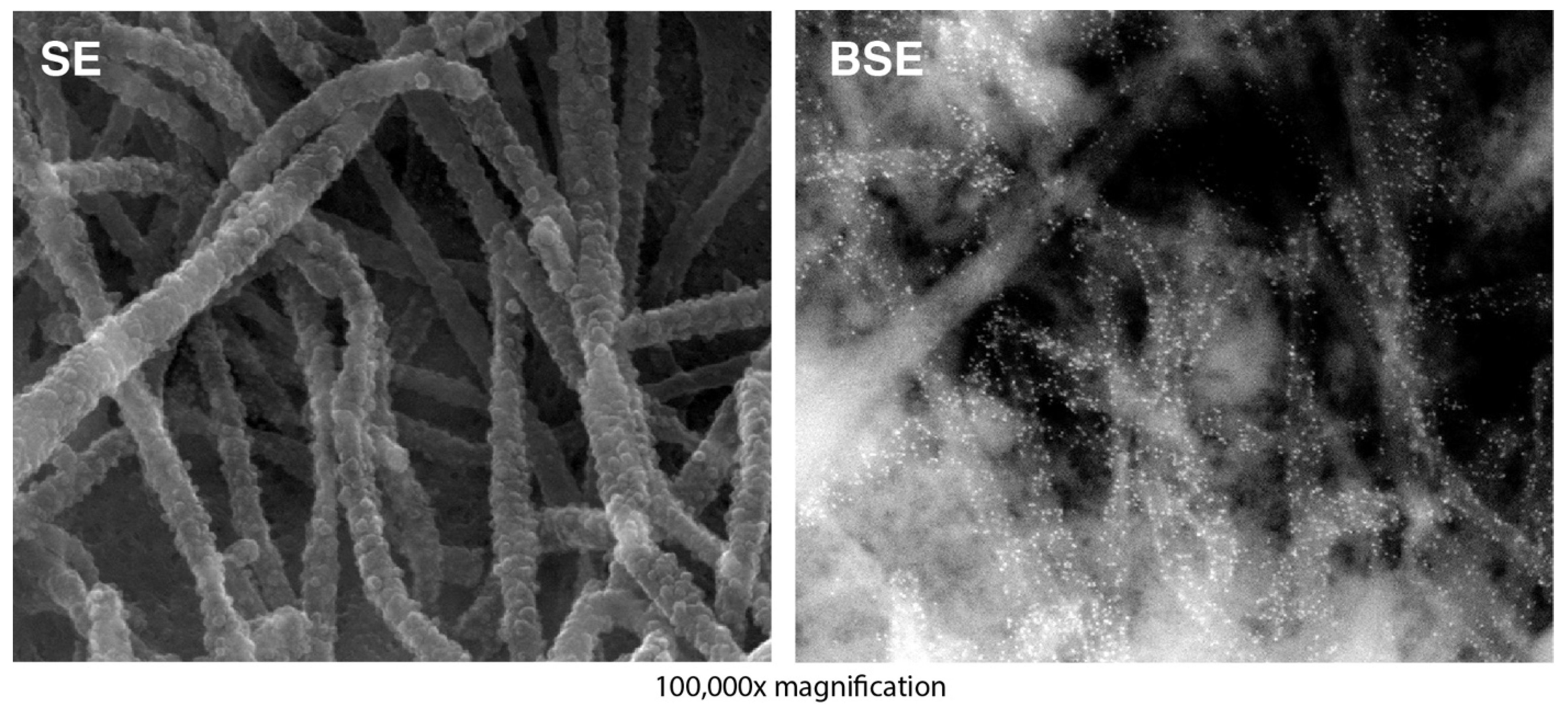
3.4. IN Applied VLP-GCR Is Immunogenic but Induces Very Low Anti-G Ab Levels (Figure 4)
3.5. VLP-GCR Vaccination Induces Severe Weight Loss after Challenge with wt RSV and Does Not Protect from Lung Pathology (Figure 5)

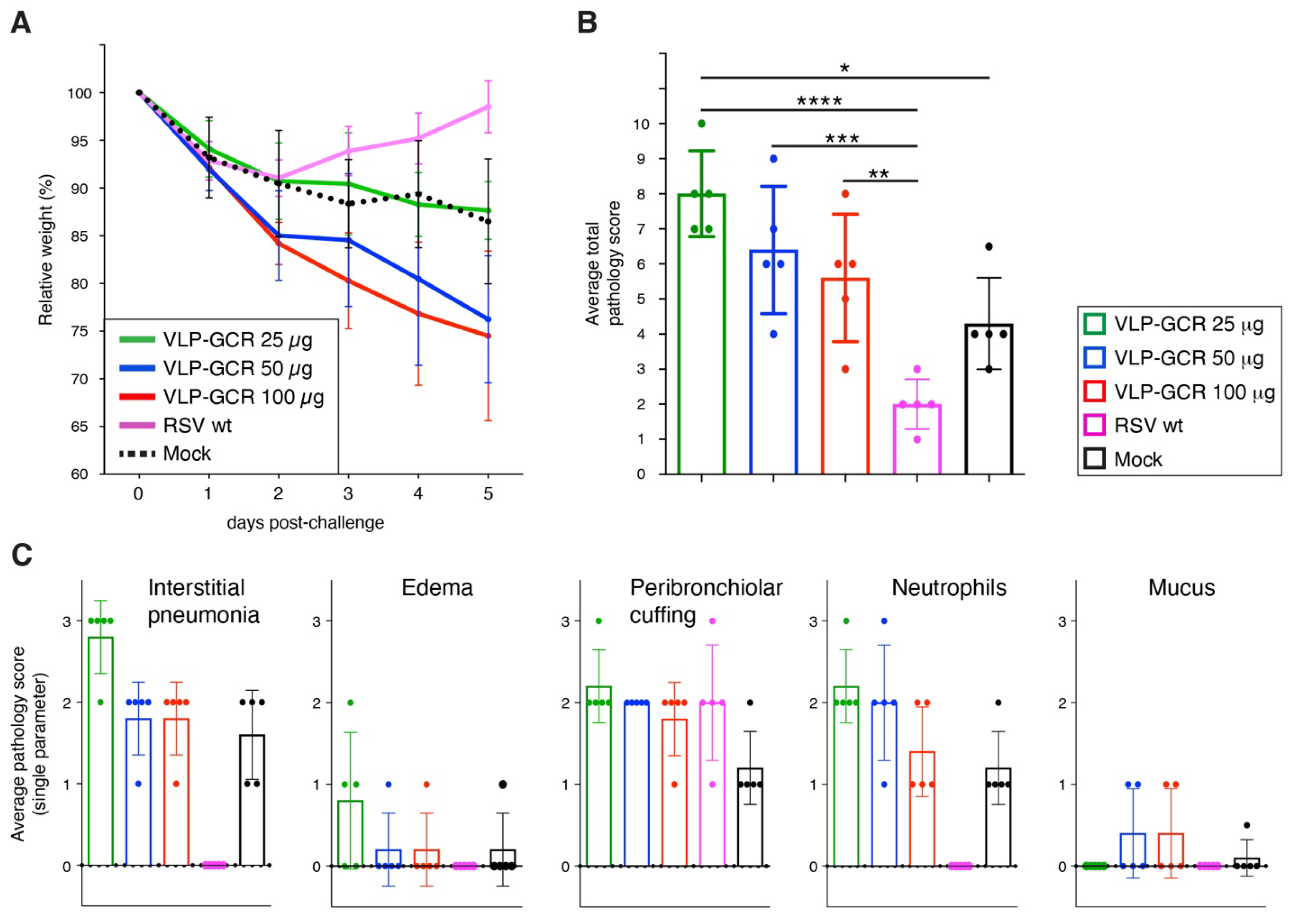
3.6. A VLP Expressing Prefusion F Induces Both Anti-F and Anti-N Abs after IN Vaccination (Figure 6)
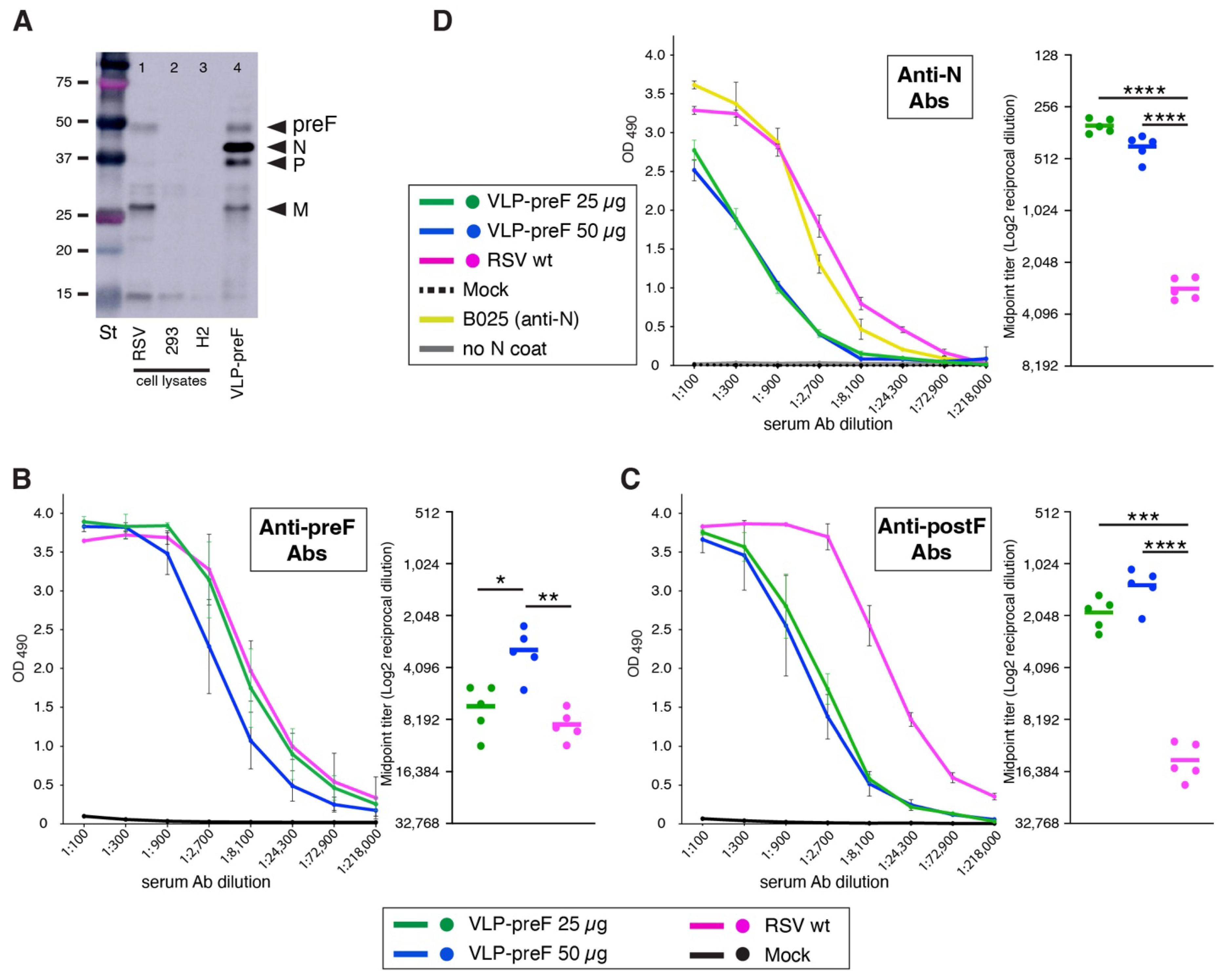
3.7. VLP-preF Vaccination Does Not Protect from Lung Pathology after Challenge in Spite of the Presence of Anti-preF Abs (Figure 7)
4. Discussion
4.1. Rationale and Design of VLP-GCR
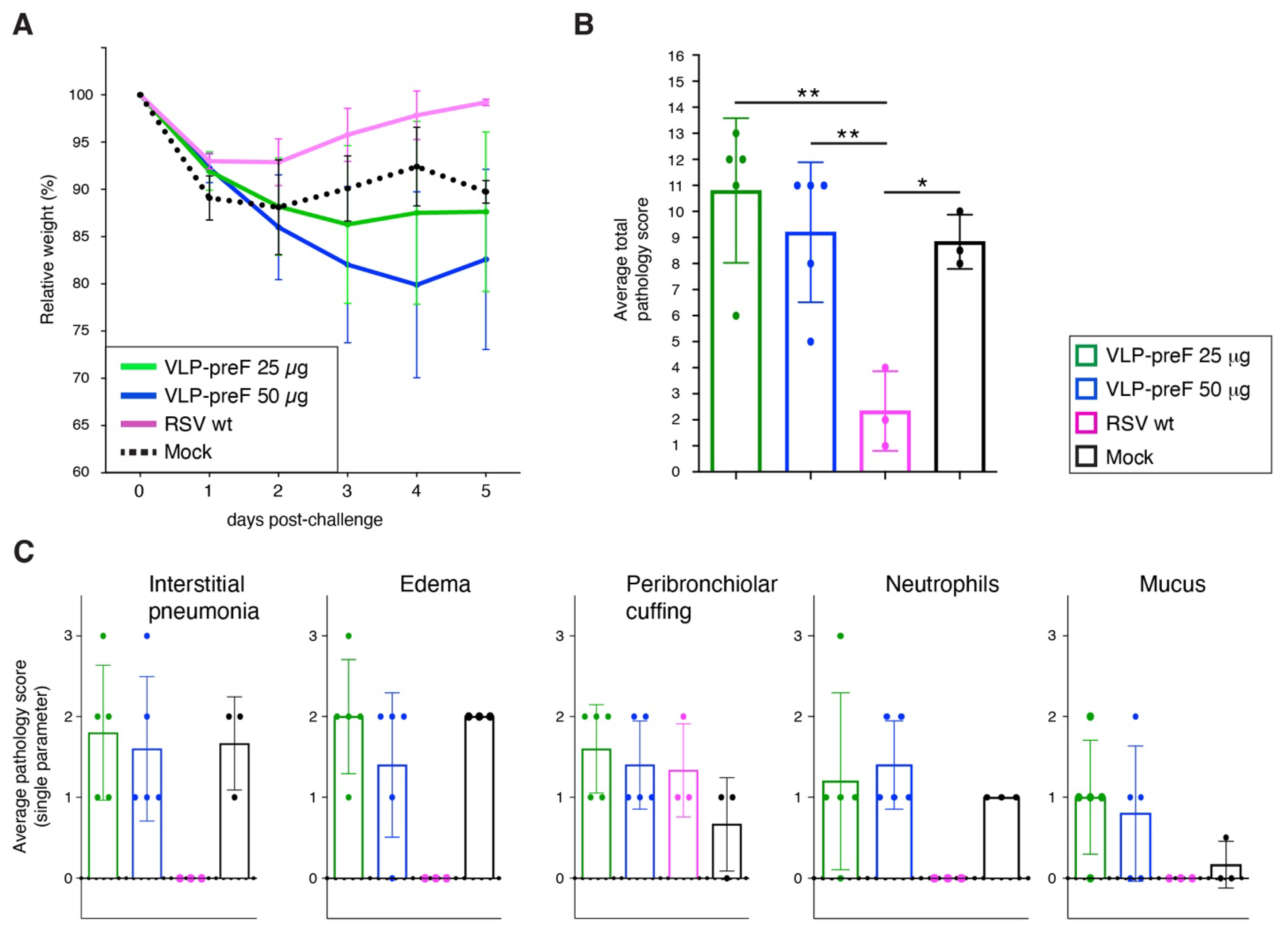
4.2. VLP-GCR Induces Very Low Levels of Anti-G Abs
4.3. Vaccination with VLP-GCR and VLP-preF Fail to Protect, and VLP-GCR Vaccination Results in Severe Weight Loss and Pathology after Challenge
4.4. In Summary
Supplementary Materials
Author Contributions
Funding
Institutional Review Board Statement
Informed Consent Statement
Data Availability Statement
Acknowledgments
Conflicts of Interest
References
- Legand, A.; Briand, S.; Shindo, N.; Brooks, W.A.; De Jong, M.D.; Farrar, J.; Aguilera, X.; Hayden, F.G. Addressing the Public Health Burden of Respiratory Viruses: The Battle against Respiratory Viruses (BRaVe) Initiative. Future Virol. 2013, 8, 953–968. [Google Scholar] [CrossRef]
- Coultas, J.A.; Smyth, R.; Openshaw, P.J. Respiratory Syncytial Virus (RSV): A Scourge from Infancy to Old Age. Thorax 2019, 74, 986–993. [Google Scholar] [CrossRef]
- Kim, H.W.; Canchola, J.G.; Brandt, C.D.; Pyles, G.; Chanock, R.M.; Jensen, K.; Parrott, R.H. Respiratory Syncytial Virus Disease in Infants Despite Prior Administration of Antigenic Inactivated Vaccine12. Am. J. Epidemiol. 1969, 89, 422–434. [Google Scholar] [CrossRef]
- Kim, H.W.; Leikin, S.L.; Arrobio, J.; Brandt, C.D.; Chanock, R.M.; Parrott, R.H. Cell-Mediated Immunity to Respiratory Syncytial Virus Induced by Inactivated Vaccine or by Infection. Pediatr. Res. 1976, 10, 75–78. [Google Scholar] [CrossRef]
- Ruckwardt, T.J.; Morabito, K.M.; Graham, B.S. Immunological Lessons from Respiratory Syncytial Virus Vaccine Development. Immunity 2019, 51, 429–442. [Google Scholar] [CrossRef]
- Mejias, A.; Rodríguez-Fernández, R.; Oliva, S.; Peeples, M.E.; Ramilo, O. The Journey to a Respiratory Syncytial Virus Vaccine. Ann. Allergy Asthma Immunol. 2020, 125, 36–46. [Google Scholar] [CrossRef]
- Bachmann, M.F.; Jennings, G.T. Vaccine Delivery: A Matter of Size, Geometry, Kinetics and Molecular Patterns. Nat. Rev. Immunol. 2010, 10, 787–796. [Google Scholar] [CrossRef]
- Grgacic, E.V.L.; Anderson, D.A. Virus-like Particles: Passport to Immune Recognition. Methods 2006, 40, 60–65. [Google Scholar] [CrossRef]
- Jennings, G.T.; Bachmann, M.F. The Coming of Age of Virus-like Particle Vaccines. Biol. Chem. 2008, 389, 521–536. [Google Scholar] [CrossRef]
- Ludwig, C.; Wagner, R. Virus-like Particles—Universal Molecular Toolboxes. Curr. Opin. Biotechnol. 2007, 18, 537–545. [Google Scholar] [CrossRef]
- Lee, Y.-N.; Hwang, H.S.; Kim, M.-C.; Lee, Y.-T.; Lee, J.S.; Moore, M.L.; Kang, S.-M. Recombinant Influenza Virus Expressing a Fusion Protein Neutralizing Epitope of Respiratory Syncytial Virus (RSV) Confers Protection without Vaccine-Enhanced RSV Disease. Antivir. Res. 2015, 115, 1–8. [Google Scholar] [CrossRef]
- Lee, Y.-N.; Suk Hwang, H.; Kim, M.-C.; Lee, Y.-T.; Cho, M.-K.; Kwon, Y.-M.; Seok Lee, J.; Plemper, R.K.; Kang, S.-M. Recombinant Influenza Virus Carrying the Conserved Domain of Respiratory Syncytial Virus (RSV) G Protein Confers Protection against RSV without Inflammatory Disease. Virology 2015, 476, 217–225. [Google Scholar] [CrossRef]
- Schmidt, M.R.; McGinnes-Cullen, L.W.; Kenward, S.A.; Willems, K.N.; Woodland, R.T.; Morrison, T.G. Modification of the Respiratory Syncytial Virus F Protein in Virus-Like Particles Impacts Generation of B Cell Memory. J. Virol. 2014, 88, 10165–10176. [Google Scholar] [CrossRef]
- McGinnes Cullen, L.; Schmidt, M.R.; Kenward, S.A.; Woodland, R.T.; Morrison, T.G. Murine Immune Responses to Virus-Like Particle-Associated Pre- and Postfusion Forms of the Respiratory Syncytial Virus F Protein. J. Virol. 2015, 89, 6835–6847. [Google Scholar] [CrossRef]
- Lee, S.-H.; Chu, K.-B.; Kim, M.-J.; Mao, J.; Eom, G.-D.; Yoon, K.-W.; Ahmed, M.A.; Quan, F.-S. Virus-like Particle Vaccine Expressing the Respiratory Syncytial Virus Pre-Fusion and G Proteins Confers Protection against RSV Challenge Infection. Pharmaceutics 2023, 15, 782. [Google Scholar] [CrossRef]
- Kim, S.; Chang, J. Baculovirus-Based Vaccine Displaying Respiratory Syncytial Virus Glycoprotein Induces Protective Immunity against RSV Infection without Vaccine-Enhanced Disease. Immune Netw. 2012, 12, 8–17. [Google Scholar] [CrossRef]
- Rainho-Tomko, J.N.; Pavot, V.; Kishko, M.; Swanson, K.; Edwards, D.; Yoon, H.; Lanza, L.; Alamares-Sapuay, J.; Osei-Bonsu, R.; Mundle, S.T.; et al. Immunogenicity and Protective Efficacy of RSV G Central Conserved Domain Vaccine with a Prefusion Nanoparticle. npj Vaccines 2022, 7, 74. [Google Scholar] [CrossRef]
- Meshram, C.D.; Baviskar, P.S.; Ognibene, C.M.; Oomens, A.G.P. The Respiratory Syncytial Virus Phosphoprotein, Matrix Protein, and Fusion Protein Carboxy-Terminal Domain Drive Efficient Filamentous Virus-Like Particle Formation. J. Virol. 2016, 90, 10612–10628. [Google Scholar] [CrossRef]
- Endt, K.; Wollmann, Y.; Haug, J.; Bernig, C.; Feigl, M.; Heiseke, A.; Kalla, M.; Hochrein, H.; Suter, M.; Chaplin, P.; et al. A Recombinant MVA-Based RSV Vaccine Induces T-Cell and Antibody Responses That Cooperate in the Protection Against RSV Infection. Front. Immunol. 2022, 13, 841471. [Google Scholar] [CrossRef]
- Jenkins, V.A.; Hoet, B.; Hochrein, H.; De Moerlooze, L. The Quest for a Respiratory Syncytial Virus Vaccine for Older Adults: Thinking beyond the F Protein. Vaccines 2023, 11, 382. [Google Scholar] [CrossRef]
- Bangham, C.R.; Openshaw, P.J.; Ball, L.A.; King, A.M.; Wertz, G.W.; Askonas, B.A. Human and Murine Cytotoxic T Cells Specific to Respiratory Syncytial Virus Recognize the Viral Nucleoprotein (N), but Not the Major Glycoprotein (G), Expressed by Vaccinia Virus Recombinants. J. Immunol. 1986, 137, 3973–3977. [Google Scholar] [CrossRef]
- Cherrie, A.H.; Anderson, K.; Wertz, G.W.; Openshaw, P.J. Human Cytotoxic T Cells Stimulated by Antigen on Dendritic Cells Recognize the N, SH, F, M, 22K, and 1b Proteins of Respiratory Syncytial Virus. J. Virol. 1992, 66, 2102–2110. [Google Scholar] [CrossRef]
- Sastre, P.; Cusi, M.G.; Manoha, C.; Schildgen, O.; Ruiz, T.; Vela, C.; Rueda, P. Serum Antibody Response to Respiratory Syncytial Virus F and N Proteins in Two Populations at High Risk of Infection: Children and Elderly. J. Virol. Methods 2010, 168, 170–176. [Google Scholar] [CrossRef] [PubMed]
- Terrosi, C.; Di Genova, G.; Savellini, G.G.; Correale, P.; Blardi, P.; Cusi, M.G. Immunological Characterization of Respiratory Syncytial Virus N Protein Epitopes Recognized by Human Cytotoxic T Lymphocytes. Viral Immunol. 2007, 20, 399–406. [Google Scholar] [CrossRef]
- Céspedes, P.F.; Bueno, S.M.; Ramírez, B.A.; Gomez, R.S.; Riquelme, S.A.; Palavecino, C.E.; Mackern-Oberti, J.P.; Mora, J.E.; Depoil, D.; Sacristán, C.; et al. Surface Expression of the hRSV Nucleoprotein Impairs Immunological Synapse Formation with T Cells. Proc. Natl. Acad. Sci. USA 2014, 111, E3214–E3223. [Google Scholar] [CrossRef]
- Liu, J.; Haddad, E.K.; Marceau, J.; Morabito, K.M.; Rao, S.S.; Filali-Mouhim, A.; Sekaly, R.-P.; Graham, B.S. A Numerically Subdominant CD8 T Cell Response to Matrix Protein of Respiratory Syncytial Virus Controls Infection with Limited Immunopathology. PLoS Pathog. 2016, 12, e1005486. [Google Scholar] [CrossRef]
- Hu, M.; Bogoyevitch, M.A.; Jans, D.A. Impact of Respiratory Syncytial Virus Infection on Host Functions: Implications for Antiviral Strategies. Physiol. Rev. 2020, 100, 1527–1594. [Google Scholar] [CrossRef] [PubMed]
- Cao, J.; Shi, M.; Zhu, L.; Li, X.; Li, A.; Wu, S.-Y.; Chiang, C.-M.; Zhang, Y. The Matrix Protein of Respiratory Syncytial Virus Suppresses Interferon Signaling via RACK1 Association. J. Virol. 2023, 97, e00747-23. [Google Scholar] [CrossRef]
- Jozwik, A.; Habibi, M.S.; Paras, A.; Zhu, J.; Guvenel, A.; Dhariwal, J.; Almond, M.; Wong, E.H.C.; Sykes, A.; Maybeno, M.; et al. RSV-Specific Airway Resident Memory CD8+ T Cells and Differential Disease Severity after Experimental Human Infection. Nat. Commun. 2015, 6, 10224. [Google Scholar] [CrossRef]
- Anderson, L.J.; Bingham, P.; Hierholzer, J.C. Neutralization of Respiratory Syncytial Virus by Individual and Mixtures of F and G Protein Monoclonal Antibodies. J. Virol. 1988, 62, 4232–4238. [Google Scholar] [CrossRef]
- Sastre, P.; Melero, J.A.; García-Barreno, B.; Palomo, C. Comparison of Affinity Chromatography and Adsorption to Vaccinia Virus Recombinant Infected Cells for Depletion of Antibodies Directed against Respiratory Syncytial Virus Glycoproteins Present in a Human Immunoglobulin Preparation. J. Med. Virol. 2005, 76, 248–255. [Google Scholar] [CrossRef]
- Lamichhane, P.; Schmidt, M.E.; Terhüja, M.; Varga, S.M.; Snider, T.A.; Rostad, C.A.; Oomens, A.G.P. A Live Single-Cycle RSV Vaccine Expressing Prefusion F Protein. Virology 2022, 577, 51–64. [Google Scholar] [CrossRef]
- Ngwuta, J.O.; Chen, M.; Modjarrad, K.; Joyce, M.G.; Kanekiyo, M.; Kumar, A.; Yassine, H.M.; Moin, S.M.; Killikelly, A.M.; Chuang, G.-Y.; et al. Prefusion F–Specific Antibodies Determine the Magnitude of RSV Neutralizing Activity in Human Sera. Sci. Transl. Med. 2015, 7, 309ra162. [Google Scholar] [CrossRef]
- Anderson, L.; Jadhao, S.; Paden, C.; Tong, S. Functional Features of the Respiratory Syncytial Virus G Protein. Viruses 2021, 13, 1214. [Google Scholar] [CrossRef] [PubMed]
- Sullender, W. Antigenic Analysis of Chimeric and Truncated G Proteins of Respiratory Syncytial Virus. Virology 1995, 209, 70–79. [Google Scholar] [CrossRef] [PubMed]
- Langedijk, J.P.M.; Schaaper, W.M.M.; Meloen, R.H.; Van Oirschot, J.T. Proposed Three-Dimensional Model for the Attachment Protein G of Respiratory Syncytial Virus. J. Gen. Virol. 1996, 77, 1249–1257. [Google Scholar] [CrossRef]
- Cane, P.A.; Martínez, I.; Pringle, C.R.; García-Barreno, B.; Melero, J.A. Antigenic Structure, Evolution and Immunobiology of Human Respiratory Syncytial Virus Attachment (G) Protein. J. Gen. Virol. 1997, 78, 2411–2418. [Google Scholar] [CrossRef]
- Johnson, S.M.; McNally, B.A.; Ioannidis, I.; Flano, E.; Teng, M.N.; Oomens, A.G.; Walsh, E.E.; Peeples, M.E. Respiratory Syncytial Virus Uses CX3CR1 as a Receptor on Primary Human Airway Epithelial Cultures. PLoS Pathog. 2015, 11, e1005318. [Google Scholar] [CrossRef]
- Chirkova, T.; Lin, S.; Oomens, A.G.P.; Gaston, K.A.; Boyoglu-Barnum, S.; Meng, J.; Stobart, C.C.; Cotton, C.U.; Hartert, T.V.; Moore, M.L.; et al. CX3CR1 Is an Important Surface Molecule for Respiratory Syncytial Virus Infection in Human Airway Epithelial Cells. J. Gen. Virol. 2015, 96, 2543–2556. [Google Scholar] [CrossRef]
- Tripp, R.A.; Jones, L.P.; Haynes, L.M.; Zheng, H.; Murphy, P.M.; Anderson, L.J. CX3C Chemokine Mimicry by Respiratory Syncytial Virus G Glycoprotein. Nat. Immunol. 2001, 2, 732–738. [Google Scholar] [CrossRef]
- Haynes, L.M.; Jones, L.P.; Barskey, A.; Anderson, L.J.; Tripp, R.A. Enhanced Disease and Pulmonary Eosinophilia Associated with Formalin-Inactivated Respiratory Syncytial Virus Vaccination Are Linked to G Glycoprotein CX3C-CX3CR1 Interaction and Expression of Substance P. J. Virol. 2003, 77, 9831–9844. [Google Scholar] [CrossRef] [PubMed]
- Tripp, R.A.; Dakhama, A.; Jones, L.P.; Barskey, A.; Gelfand, E.W.; Anderson, L.J. The G Glycoprotein of Respiratory Syncytial Virus Depresses Respiratory Rates through the CX3C Motif and Substance P. J. Virol. 2003, 77, 6580–6584. [Google Scholar] [CrossRef] [PubMed]
- Harcourt, J.; Alvarez, R.; Jones, L.P.; Henderson, C.; Anderson, L.J.; Tripp, R.A. Respiratory Syncytial Virus G Protein and G Protein CX3C Motif Adversely Affect CX3CR1+ T Cell Responses. J. Immunol. 2006, 176, 1600–1608. [Google Scholar] [CrossRef] [PubMed]
- Johnson, T.R.; McLellan, J.S.; Graham, B.S. Respiratory Syncytial Virus Glycoprotein G Interacts with DC-SIGN and L-SIGN To Activate ERK1 and ERK2. J. Virol. 2012, 86, 1339–1347. [Google Scholar] [CrossRef] [PubMed]
- Chirkova, T.; Boyoglu-Barnum, S.; Gaston, K.A.; Malik, F.M.; Trau, S.P.; Oomens, A.G.P.; Anderson, L.J. Respiratory Syncytial Virus G Protein CX3C Motif Impairs Human Airway Epithelial and Immune Cell Responses. J. Virol. 2013, 87, 13466–13479. [Google Scholar] [CrossRef] [PubMed]
- Bergeron, H.C.; Tripp, R.A. RSV Replication, Transmission, and Disease Are Influenced by the RSV G Protein. Viruses 2022, 14, 2396. [Google Scholar] [CrossRef] [PubMed]
- Zhang, W.; Choi, Y.; Haynes, L.M.; Harcourt, J.L.; Anderson, L.J.; Jones, L.P.; Tripp, R.A. Vaccination To Induce Antibodies Blocking the CX3C-CX3CR1 Interaction of Respiratory Syncytial Virus G Protein Reduces Pulmonary Inflammation and Virus Replication in Mice. J. Virol. 2010, 84, 1148–1157. [Google Scholar] [CrossRef] [PubMed]
- Haynes, L.M.; Caidi, H.; Radu, G.U.; Miao, C.; Harcourt, J.L.; Tripp, R.A.; Anderson, L.J. Therapeutic Monoclonal Antibody Treatment Targeting Respiratory Syncytial Virus (RSV) G Protein Mediates Viral Clearance and Reduces the Pathogenesis of RSV Infection in BALB/c Mice. J. Infect. Dis. 2009, 200, 439–447. [Google Scholar] [CrossRef] [PubMed]
- Radu, G.U.; Caidi, H.; Miao, C.; Tripp, R.A.; Anderson, L.J.; Haynes, L.M. Prophylactic Treatment with a G Glycoprotein Monoclonal Antibody Reduces Pulmonary Inflammation in Respiratory Syncytial Virus (RSV)-Challenged Naïve and Formalin-Inactivated RSV-Immunized BALB/c Mice. J. Virol. 2010, 84, 9632–9636. [Google Scholar] [CrossRef]
- Caidi, H.; Harcourt, J.L.; Tripp, R.A.; Anderson, L.J.; Haynes, L.M. Combination Therapy Using Monoclonal Antibodies against Respiratory Syncytial Virus (RSV) G Glycoprotein Protects from RSV Disease in BALB/c Mice. PLoS ONE 2012, 7, e51485. [Google Scholar] [CrossRef]
- Choi, Y.; Mason, C.S.; Jones, L.P.; Crabtree, J.; Jorquera, P.A.; Tripp, R.A. Antibodies to the Central Conserved Region of Respiratory Syncytial Virus (RSV) G Protein Block RSV G Protein CX3C-CX3CR1 Binding and Cross-Neutralize RSV A and B Strains. Viral Immunol. 2012, 25, 120502120244005. [Google Scholar] [CrossRef] [PubMed]
- Boyoglu-Barnum, S.; Gaston, K.A.; Todd, S.O.; Boyoglu, C.; Chirkova, T.; Barnum, T.R.; Jorquera, P.; Haynes, L.M.; Tripp, R.A.; Moore, M.L.; et al. A Respiratory Syncytial Virus (RSV) Anti-G Protein F(Ab′)2 Monoclonal Antibody Suppresses Mucous Production and Breathing Effort in RSV rA2-line19F-Infected BALB/c Mice. J. Virol. 2013, 87, 10955–10967. [Google Scholar] [CrossRef] [PubMed]
- Jorquera, P.A.; Choi, Y.; Oakley, K.E.; Powell, T.J.; Boyd, J.G.; Palath, N.; Haynes, L.M.; Anderson, L.J.; Tripp, R.A. Nanoparticle Vaccines Encompassing the Respiratory Syncytial Virus (RSV) G Protein CX3C Chemokine Motif Induce Robust Immunity Protecting from Challenge and Disease. PLoS ONE 2013, 8, e74905. [Google Scholar] [CrossRef] [PubMed]
- Jorquera, P.; Tripp, R. Synthetic Biodegradable Microparticle and Nanoparticle Vaccines against the Respiratory Syncytial Virus. Vaccines 2016, 4, 45. [Google Scholar] [CrossRef] [PubMed]
- Caidi, H.; Miao, C.; Thornburg, N.J.; Tripp, R.A.; Anderson, L.J.; Haynes, L.M. Anti-Respiratory Syncytial Virus (RSV) G Monoclonal Antibodies Reduce Lung Inflammation and Viral Lung Titers When Delivered Therapeutically in a BALB/c Mouse Model. Antivir. Res. 2018, 154, 149–157. [Google Scholar] [CrossRef] [PubMed]
- Cane, P.A.; Thomas, H.M.; Simpson, A.F.; Evans, J.E.; Hart, C.A.; Pringle, C.R. Analysis of the Human Serological Immune Response to a Variable Region of the Attachment (G) Protein of Respiratory Syncytial Virus during Primary Infection. J. Med. Virol. 1996, 48, 253–261. [Google Scholar] [CrossRef]
- Liang, B.; Kabatova, B.; Kabat, J.; Dorward, D.W.; Liu, X.; Surman, S.; Liu, X.; Moseman, A.P.; Buchholz, U.J.; Collins, P.L.; et al. Effects of Alterations to the CX3C Motif and Secreted Form of Human Respiratory Syncytial Virus (RSV) G Protein on Immune Responses to a Parainfluenza Virus Vector Expressing the RSV G Protein. J. Virol. 2019, 93, e02043-18. [Google Scholar] [CrossRef] [PubMed]
- Plotnicky-Gilquin, H.; Goetsch, L.; Huss, T.; Champion, T.; Beck, A.; Haeuw, J.-F.; Nguyen, T.N.; Bonnefoy, J.-Y.; Corvaïa, N.; Power, U.F. Identification of Multiple Protective Epitopes (Protectopes) in the Central Conserved Domain of a Prototype Human Respiratory Syncytial Virus G Protein. J. Virol. 1999, 73, 5637–5645. [Google Scholar] [CrossRef]
- Power, U.F.; Nguyen, T.N.; Rietveld, E.; de Swart, R.L.; Groen, J.; Osterhaus, A.D.M.E.; de Groot, R.; Corvaia, N.; Beck, A.; Bouveret-le-Cam, N.; et al. Safety and Immunogenicity of a Novel Recombinant Subunit Respiratory Syncytial Virus Vaccine (BBG2Na) in Healthy Young Adults. J. Infect. Dis. 2001, 184, 1456–1460. [Google Scholar] [CrossRef]
- Roe, M.K.; Perez, M.A.; Hsiao, H.-M.; Lapp, S.A.; Sun, H.-Y.; Jadhao, S.; Young, A.R.; Batista, Y.S.; Reed, R.C.; Taz, A.; et al. An RSV Live-Attenuated Vaccine Candidate Lacking G Protein Mucin Domains Is Attenuated, Immunogenic, and Effective in Preventing RSV in BALB/c Mice. J. Infect. Dis. 2022, 227, 50–60. [Google Scholar] [CrossRef]
- Ha, B.; Yang, J.E.; Chen, X.; Jadhao, S.J.; Wright, E.R.; Anderson, L.J. Two RSV Platforms for G, F, or G+F Proteins VLPs. Viruses 2020, 12, 906. [Google Scholar] [CrossRef] [PubMed]
- Baviskar, P.S.; Hotard, A.L.; Moore, M.L.; Oomens, A.G.P. The Respiratory Syncytial Virus Fusion Protein Targets to the Perimeter of Inclusion Bodies and Facilitates Filament Formation by a Cytoplasmic Tail-Dependent Mechanism. J. Virol. 2013, 87, 10730–10741. [Google Scholar] [CrossRef] [PubMed]
- Shaikh, F.Y.; Cox, R.G.; Lifland, A.W.; Hotard, A.L.; Williams, J.V.; Moore, M.L.; Santangelo, P.J.; Crowe, J.E. A Critical Phenylalanine Residue in the Respiratory Syncytial Virus Fusion Protein Cytoplasmic Tail Mediates Assembly of Internal Viral Proteins into Viral Filaments and Particles. mBio 2012, 3, e00270-11. [Google Scholar] [CrossRef] [PubMed]
- Feldman, S.A.; Hendry, R.M.; Beeler, J.A. Identification of a Linear Heparin Binding Domain for Human Respiratory Syncytial Virus Attachment Glycoprotein G. J. Virol. 1999, 73, 6610–6617. [Google Scholar] [CrossRef]
- Groskreutz, D.J.; Babor, E.C.; Monick, M.M.; Varga, S.M.; Hunninghake, G.W. Respiratory Syncytial Virus Limits α Subunit of Eukaryotic Translation Initiation Factor 2 (eIF2α) Phosphorylation to Maintain Translation and Viral Replication. J. Biol. Chem. 2010, 285, 24023–24031. [Google Scholar] [CrossRef] [PubMed]
- Fricke, J.; Koo, L.Y.; Brown, C.R.; Collins, P.L. P38 and OGT Sequestration into Viral Inclusion Bodies in Cells Infected with Human Respiratory Syncytial Virus Suppresses MK2 Activities and Stress Granule Assembly. J. Virol. 2013, 87, 1333–1347. [Google Scholar] [CrossRef]
- Jobe, F.; Simpson, J.; Hawes, P.; Guzman, E.; Bailey, D. Respiratory Syncytial Virus Sequesters NF-κB Subunit P65 to Cytoplasmic Inclusion Bodies To Inhibit Innate Immune Signaling. J. Virol. 2020, 94, e01380-20. [Google Scholar] [CrossRef] [PubMed]
- Turner, D.L.; Bickham, K.L.; Thome, J.J.; Kim, C.Y.; D’Ovidio, F.; Wherry, E.J.; Farber, D.L. Lung Niches for the Generation and Maintenance of Tissue-Resident Memory T Cells. Mucosal Immunol. 2014, 7, 501–510. [Google Scholar] [CrossRef] [PubMed]
- Knudson, C.J.; Weiss, K.A.; Hartwig, S.M.; Varga, S.M. The Pulmonary Localization of Virus-Specific T Lymphocytes Is Governed by the Tissue Tropism of Infection. J. Virol. 2014, 88, 9010–9016. [Google Scholar] [CrossRef]
- Habibi, M.S.; Jozwik, A.; Makris, S.; Dunning, J.; Paras, A.; DeVincenzo, J.P.; De Haan, C.A.M.; Wrammert, J.; Openshaw, P.J.M.; Chiu, C. Impaired Antibody-Mediated Protection and Defective IgA B-Cell Memory in Experimental Infection of Adults with Respiratory Syncytial Virus. Am. J. Respir. Crit. Care Med. 2015, 191, 1040–1049. [Google Scholar] [CrossRef]
- Schmidt, M.E.; Varga, S.M. Modulation of the Host Immune Response by Respiratory Syncytial Virus Proteins. J. Microbiol. 2017, 55, 161–171. [Google Scholar] [CrossRef]
- Van Ginkel, F.W.; Jackson, R.J.; Yuki, Y.; McGhee, J.R. Cutting Edge: The Mucosal Adjuvant Cholera Toxin Redirects Vaccine Proteins into Olfactory Tissues. J. Immunol. 2000, 165, 4778–4782. [Google Scholar] [CrossRef]
- Fujihashi, K.; Koga, T.; Van Ginkel, F.W.; Hagiwara, Y.; McGhee, J.R. A Dilemma for Mucosal Vaccination: Efficacy versus Toxicity Using Enterotoxin-Based Adjuvants. Vaccine 2002, 20, 2431–2438. [Google Scholar] [CrossRef]
- Lemiale, F.; Kong, W.; Akyürek, L.M.; Ling, X.; Huang, Y.; Chakrabarti, B.K.; Eckhaus, M.; Nabel, G.J. Enhanced Mucosal Immunoglobulin A Response of Intranasal Adenoviral Vector Human Immunodeficiency Virus Vaccine and Localization in the Central Nervous System. J. Virol. 2003, 77, 10078–10087. [Google Scholar] [CrossRef]
- Armstrong, M.E.; Lavelle, E.C.; Loscher, C.E.; Lynch, M.A.; Mills, K.H.G. Proinflammatory Responses in the Murine Brain after Intranasal Delivery of Cholera Toxin: Implications for the Use of AB Toxins as Adjuvants in Intranasal Vaccines. J. Infect. Dis. 2005, 192, 1628–1633. [Google Scholar] [CrossRef]
- Waris, M.E.; Tsou, C.; Erdman, D.D.; Day, D.B.; Anderson, L.J. Priming with Live Respiratory Syncytial Virus (RSV) Prevents the Enhanced Pulmonary Inflammatory Response Seen after RSV Challenge in BALB/c Mice Immunized with Formalin-Inactivated RSV. J. Virol. 1997, 71, 6935–6939. [Google Scholar] [CrossRef]
- Walsh, E.E.; Brandriss, M.W.; Schlesinger, J.J. Immunological Differences between the Envelope Glycoproteins of Two Strains of Human Respiratory Syncytial Virus. J. Gen. Virol. 1987, 68, 2169–2176. [Google Scholar] [CrossRef]
- Anderson, L.J.; Hierholzer, J.C.; Tsou, C.; Hendry, R.M.; Fernie, B.F.; Stone, Y.; McIntosh, K. Antigenic Characterization of Respiratory Syncytial Virus Strains with Monoclonal Antibodies. J. Infect. Dis. 1985, 151, 626–633. [Google Scholar] [CrossRef] [PubMed]
- Mitra, R.; Baviskar, P.; Duncan-Decocq, R.R.; Patel, D.; Oomens, A.G.P. The Human Respiratory Syncytial Virus Matrix Protein Is Required for Maturation of Viral Filaments. J. Virol. 2012, 86, 4432–4443. [Google Scholar] [CrossRef] [PubMed]
- Meshram, C.D.; Oomens, A.G.P. Identification of a Human Respiratory Syncytial Virus Phosphoprotein Domain Required for Virus-like-Particle Formation. Virology 2019, 532, 48–54. [Google Scholar] [CrossRef] [PubMed]
- McLellan, J.S.; Chen, M.; Joyce, M.G.; Sastry, M.; Stewart-Jones, G.B.E.; Yang, Y.; Zhang, B.; Chen, L.; Srivatsan, S.; Zheng, A.; et al. Structure-Based Design of a Fusion Glycoprotein Vaccine for Respiratory Syncytial Virus. Science 2013, 342, 592–598. [Google Scholar] [CrossRef]
- Lamichhane, P.; Terhüja, M.; Snider, T.A.; Oomens, A.G.P. Enhancing Anti-G Antibody Induction by a Live Single-Cycle Prefusion F—Expressing RSV Vaccine Improves In Vitro and In Vivo Efficacy. Viruses 2022, 14, 2474. [Google Scholar] [CrossRef]
- Monsma, S.A.; Oomens, A.G.; Blissard, G.W. The GP64 Envelope Fusion Protein Is an Essential Baculovirus Protein Required for Cell-to-Cell Transmission of Infection. J. Virol. 1996, 70, 4607–4616. [Google Scholar] [CrossRef]
- Graham, B.S.; Bunton, L.A.; Wright, P.F.; Karzon, D.T. Role of T Lymphocyte Subsets in the Pathogenesis of Primary Infection and Rechallenge with Respiratory Syncytial Virus in Mice. J. Clin. Investig. 1991, 88, 1026–1033. [Google Scholar] [CrossRef]
- Jorquera, P.; Oakley, K.; Powell, T.; Palath, N.; Boyd, J.; Tripp, R. Layer-By-Layer Nanoparticle Vaccines Carrying the G Protein CX3C Motif Protect against RSV Infection and Disease. Vaccines 2015, 3, 829–849. [Google Scholar] [CrossRef]
- Firdous, J.; Islam, M.A.; Park, S.-M.; Cheon, I.-S.; Shim, B.-S.; Yoon, H.-S.; Song, M.; Chang, J.; Choi, Y.-J.; Park, Y.-M.; et al. Induction of Long-Term Immunity against Respiratory Syncytial Virus Glycoprotein by an Osmotic Polymeric Nanocarrier. Acta Biomater. 2014, 10, 4606–4617. [Google Scholar] [CrossRef]
- Lee, S.; Quan, F.-S.; Kwon, Y.; Sakamoto, K.; Kang, S.-M.; Compans, R.W.; Moore, M.L. Additive Protection Induced by Mixed Virus-like Particles Presenting Respiratory Syncytial Virus Fusion or Attachment Glycoproteins. Antivir. Res. 2014, 111, 129–135. [Google Scholar] [CrossRef]
- Johnson, T.R.; Teng, M.N.; Collins, P.L.; Graham, B.S. Respiratory Syncytial Virus (RSV) G Glycoprotein Is Not Necessary for Vaccine-Enhanced Disease Induced by Immunization with Formalin-Inactivated RSV. J. Virol. 2004, 78, 6024–6032. [Google Scholar] [CrossRef]
- Murawski, M.R.; McGinnes, L.W.; Finberg, R.W.; Kurt-Jones, E.A.; Massare, M.J.; Smith, G.; Heaton, P.M.; Fraire, A.E.; Morrison, T.G. Newcastle Disease Virus-Like Particles Containing Respiratory Syncytial Virus G Protein Induced Protection in BALB/c Mice, with No Evidence of Immunopathology. J. Virol. 2010, 84, 1110–1123. [Google Scholar] [CrossRef] [PubMed]
- Murphy, B.R.; Sotnikov, A.V.; Lawrence, L.A.; Banks, S.M.; Prince, G.A. Enhanced Pulmonary Histopathology Is Observed in Cotton Rats Immunized with Formalin-Inactivated Respiratory Syncytial Virus (RSV) or Purified F Glycoprotein and Challenged with RSV 3–6 Months after Immunization. Vaccine 1990, 8, 497–502. [Google Scholar] [CrossRef] [PubMed]
- Connors, M.; Collins, P.L.; Firestone, C.-Y.; Sotnikov, A.V.; Waitze, A.; Davis, A.R.; Hung, P.P.; Chanock, R.M.; Murphy, B.R. Cotton Rats Previously Immunized with a Chimeric RSV FG Glycoprotein Develop Enhanced Pulmonary Pathology When Infected with RSV, a Phenomenon Not Encountered Following Immunization with Vaccinia—RSV Recombinants or RSV. Vaccine 1992, 10, 475–484. [Google Scholar] [CrossRef]
- Hancock, G.E.; Speelman, D.J.; Heers, K.; Bortell, E.; Smith, J.; Cosco, C. Generation of Atypical Pulmonary Inflammatory Responses in BALB/c Mice after Immunization with the Native Attachment (G) Glycoprotein of Respiratory Syncytial Virus. J. Virol. 1996, 70, 7783–7791. [Google Scholar] [CrossRef]
- Johnson, T.R.; Johnson, J.E.; Roberts, S.R.; Wertz, G.W.; Parker, R.A.; Graham, B.S. Priming with Secreted Glycoprotein G of Respiratory Syncytial Virus (RSV) Augments Interleukin-5 Production and Tissue Eosinophilia after RSV Challenge. J. Virol. 1998, 72, 2871–2880. [Google Scholar] [CrossRef]
- Acosta, P.L.; Caballero, M.T.; Polack, F.P. Brief History and Characterization of Enhanced Respiratory Syncytial Virus Disease. Clin. Vaccine Immunol. 2016, 23, 189–195. [Google Scholar] [CrossRef]
- Thwaites, R.S.; Coates, M.; Ito, K.; Ghazaly, M.; Feather, C.; Abdulla, F.; Tunstall, T.; Jain, P.; Cass, L.; Rapeport, G.; et al. Reduced Nasal Viral Load and IFN Responses in Infants with Respiratory Syncytial Virus Bronchiolitis and Respiratory Failure. Am. J. Respir. Crit. Care Med. 2018, 198, 1074–1084. [Google Scholar] [CrossRef]
- Habibi, M.S.; Thwaites, R.S.; Chang, M.; Jozwik, A.; Paras, A.; Kirsebom, F.; Varese, A.; Owen, A.; Cuthbertson, L.; James, P.; et al. Neutrophilic Inflammation in the Respiratory Mucosa Predisposes to RSV Infection. Science 2020, 370, eaba9301. [Google Scholar] [CrossRef]
- Fujisawa, T.; Velichko, S.; Thai, P.; Hung, L.-Y.; Huang, F.; Wu, R. Regulation of Airway MUC5AC Expression by IL-1β and IL-17A; the NF-κB Paradigm. J. Immunol. 2009, 183, 6236–6243. [Google Scholar] [CrossRef]
- De Almeida Nagata, D.E.; Demoor, T.; Ptaschinski, C.; Ting, H.-A.; Jang, S.; Reed, M.; Mukherjee, S.; Lukacs, N.W. IL-27R–Mediated Regulation of IL-17 Controls the Development of Respiratory Syncytial Virus–Associated Pathogenesis. Am. J. Pathol. 2014, 184, 1807–1818. [Google Scholar] [CrossRef]
- Onishi, R.M.; Gaffen, S.L. Interleukin-17 and Its Target Genes: Mechanisms of Interleukin-17 Function in Disease. Immunology 2010, 129, 311–321. [Google Scholar] [CrossRef]
- Mills, K.H.G. IL-17 and IL-17-Producing Cells in Protection versus Pathology. Nat. Rev. Immunol. 2023, 23, 38–54. [Google Scholar] [CrossRef]
- Knudson, C.J.; Hartwig, S.M.; Meyerholz, D.K.; Varga, S.M. RSV Vaccine-Enhanced Disease Is Orchestrated by the Combined Actions of Distinct CD4 T Cell Subsets. PLoS Pathog. 2015, 11, e1004757. [Google Scholar] [CrossRef]
- Moore, M.L.; Chi, M.H.; Luongo, C.; Lukacs, N.W.; Polosukhin, V.V.; Huckabee, M.M.; Newcomb, D.C.; Buchholz, U.J.; Crowe, J.E.; Goleniewska, K.; et al. A Chimeric A2 Strain of Respiratory Syncytial Virus (RSV) with the Fusion Protein of RSV Strain Line 19 Exhibits Enhanced Viral Load, Mucus, and Airway Dysfunction. J. Virol. 2009, 83, 4185–4194. [Google Scholar] [CrossRef]
- Hotard, A.L.; Lee, S.; Currier, M.G.; Crowe, J.E.; Sakamoto, K.; Newcomb, D.C.; Peebles, R.S.; Plemper, R.K.; Moore, M.L. Identification of Residues in the Human Respiratory Syncytial Virus Fusion Protein That Modulate Fusion Activity and Pathogenesis. J. Virol. 2015, 89, 512–522. [Google Scholar] [CrossRef]
Disclaimer/Publisher’s Note: The statements, opinions and data contained in all publications are solely those of the individual author(s) and contributor(s) and not of MDPI and/or the editor(s). MDPI and/or the editor(s) disclaim responsibility for any injury to people or property resulting from any ideas, methods, instructions or products referred to in the content. |
© 2024 by the authors. Licensee MDPI, Basel, Switzerland. This article is an open access article distributed under the terms and conditions of the Creative Commons Attribution (CC BY) license (https://creativecommons.org/licenses/by/4.0/).
Share and Cite
Terhüja, M.; Siddappa, M.; Lamichhane, P.; Meshram, C.D.; Snider, T.A.; Ritchey, J.W.; Oomens, A.G.P. Intranasal Vaccination with a Respiratory-Syncytial-Virus-Based Virus-like Particle Displaying the G Protein Conserved Region Induces Severe Weight Loss and Pathology upon Challenge with Wildtype Respiratory Syncytial Virus. Viruses 2024, 16, 843. https://doi.org/10.3390/v16060843
Terhüja M, Siddappa M, Lamichhane P, Meshram CD, Snider TA, Ritchey JW, Oomens AGP. Intranasal Vaccination with a Respiratory-Syncytial-Virus-Based Virus-like Particle Displaying the G Protein Conserved Region Induces Severe Weight Loss and Pathology upon Challenge with Wildtype Respiratory Syncytial Virus. Viruses. 2024; 16(6):843. https://doi.org/10.3390/v16060843
Chicago/Turabian StyleTerhüja, Megolhubino, Manjunath Siddappa, Pramila Lamichhane, Chetan D. Meshram, Timothy A. Snider, Jerry W. Ritchey, and Antonius G. P. Oomens. 2024. "Intranasal Vaccination with a Respiratory-Syncytial-Virus-Based Virus-like Particle Displaying the G Protein Conserved Region Induces Severe Weight Loss and Pathology upon Challenge with Wildtype Respiratory Syncytial Virus" Viruses 16, no. 6: 843. https://doi.org/10.3390/v16060843
APA StyleTerhüja, M., Siddappa, M., Lamichhane, P., Meshram, C. D., Snider, T. A., Ritchey, J. W., & Oomens, A. G. P. (2024). Intranasal Vaccination with a Respiratory-Syncytial-Virus-Based Virus-like Particle Displaying the G Protein Conserved Region Induces Severe Weight Loss and Pathology upon Challenge with Wildtype Respiratory Syncytial Virus. Viruses, 16(6), 843. https://doi.org/10.3390/v16060843





